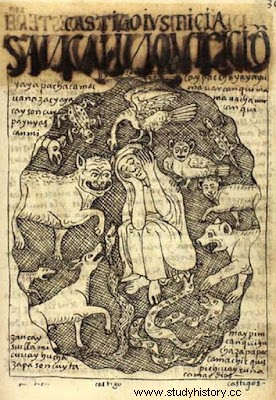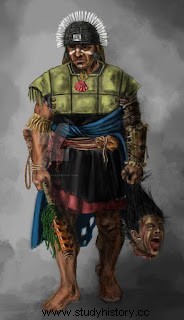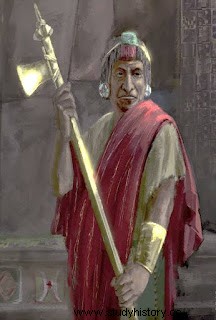 The Sancayhuasi, place of torment for the enemies of the Inca, by Guamán Poma de Ayala I have created this analysis based on some data from Guamán Poma de Ayala, Fray Martín de Murúa and mainly on the chronicles of Juan de Betanzos. The latter, as we all know, lived in the palaces of the highest Inca nobility in colonial times, in Cusco. His sources are first-hand and he is one of the few that tries to be impartial, despite the time. You know that the forms of Inca conquest were of two types:By conviction (the Inca negotiated a deal in exchange for power over the kingdom ) and the other by submission (by force and with war). In the latter case, many of the kingdoms that the Inca could not conquer by conviction, were considered stubborn and rebellious kingdoms, so they proceeded to blood. After the carnage that took place on the battlefields, they proceeded to thank the huaca that they had carried as a protector of war, loaded on a litter. Then the construction of a temple in homage to the Inca pantheon, sacrifices, ceremonies, offerings and the construction of public institutions, which would give the conquered kingdom a new direction. Following act, the bodies of the allies were collected to be taken to Cusco and delivered to the widows, while those of the counterpart were left to rot scattered in the field as punishment. Likewise, they proceeded to "magical, physical and psychological punishments" carried out mainly on people of the highest positions. Killing the rebel Cápac, that is, the great lord who did not want to submit to the Inca, was vital in a war of this type, since by killing him, the head and the philosophical thought of the conquered kingdom automatically died.
The Sancayhuasi, place of torment for the enemies of the Inca, by Guamán Poma de Ayala I have created this analysis based on some data from Guamán Poma de Ayala, Fray Martín de Murúa and mainly on the chronicles of Juan de Betanzos. The latter, as we all know, lived in the palaces of the highest Inca nobility in colonial times, in Cusco. His sources are first-hand and he is one of the few that tries to be impartial, despite the time. You know that the forms of Inca conquest were of two types:By conviction (the Inca negotiated a deal in exchange for power over the kingdom ) and the other by submission (by force and with war). In the latter case, many of the kingdoms that the Inca could not conquer by conviction, were considered stubborn and rebellious kingdoms, so they proceeded to blood. After the carnage that took place on the battlefields, they proceeded to thank the huaca that they had carried as a protector of war, loaded on a litter. Then the construction of a temple in homage to the Inca pantheon, sacrifices, ceremonies, offerings and the construction of public institutions, which would give the conquered kingdom a new direction. Following act, the bodies of the allies were collected to be taken to Cusco and delivered to the widows, while those of the counterpart were left to rot scattered in the field as punishment. Likewise, they proceeded to "magical, physical and psychological punishments" carried out mainly on people of the highest positions. Killing the rebel Cápac, that is, the great lord who did not want to submit to the Inca, was vital in a war of this type, since by killing him, the head and the philosophical thought of the conquered kingdom automatically died. THE HEAD AND THE CAM: The lord of Collasuyu, for example (who was a very powerful guy and owner of large estates in the south) was beheaded and his head, by order of the Inca, should be preserved and decorated, that is, mummified for his preservation. Although it might sound terrifying for our current world, at that time it was common for people of power in the pre-Columbian Andes (I am talking about Incas and pre-Incas) to take the enemy's head as a "cámac prison", that is, "to trap in the head, the force-spirit of the opponent, take his power through the retention of it, to be stronger and govern his people”. An example of this, we have the trophy heads of the Nazca culture, to which any type of hole was closed so that the "camac" would not escape. But anyway, it was not a trophy for fear, terrorizing people and hanging them in the square, as they did in the West. It was kept in one of the galleries of the Yachayhuasi and was available to the Inca and the rituals. The war ended up being magical, the head was with the new lord and the conquered people had to obey their new Cápac.
 Inca warrior, realistic reconstruction by illustrator Frank Abarca. 2.- MAGICAL APPROPRIATION AND RECIPROCITY: Next step, the spoils of war, called "Pineapple", were taken. It consisted of gathering the luxury goods of the conquered kingdom, such as gold, silver, camelids and the most beautiful fabrics. These fabrics were, for the most part, the clothing of the officials and the Cápac subjugated, which the Inca ordered to adorn them with red tassels the size of a jeme (distance from the thumb to the index finger) as a symbol of subjugation. Then the Inca stepped on all the loot, including the "borleadas" clothes of the enemies, to later dispose of them. The public act of the Inca, of stepping on someone else's property with his own feet, automatically belonged to him and became sacred. Afterwards he proceeded to offer them:the most beautiful to the bonfire, along with food and animals, for all the huacas of the Hanan Pacha (especially of the Sun and the Lightning) and what was left over for his allies. And know that he had to have enough left over, because loot was the most important act of reciprocity after the war, it was like paying his allies and generals for services rendered. It is said that once, Huayna Cápac (and this is what Murúa tells) did not prioritize the distribution of the spoils of war in a battle and the troops turned their back on him. The desperate Inca had to act quickly so that they would not abandon him and give them what they wanted.
Inca warrior, realistic reconstruction by illustrator Frank Abarca. 2.- MAGICAL APPROPRIATION AND RECIPROCITY: Next step, the spoils of war, called "Pineapple", were taken. It consisted of gathering the luxury goods of the conquered kingdom, such as gold, silver, camelids and the most beautiful fabrics. These fabrics were, for the most part, the clothing of the officials and the Cápac subjugated, which the Inca ordered to adorn them with red tassels the size of a jeme (distance from the thumb to the index finger) as a symbol of subjugation. Then the Inca stepped on all the loot, including the "borleadas" clothes of the enemies, to later dispose of them. The public act of the Inca, of stepping on someone else's property with his own feet, automatically belonged to him and became sacred. Afterwards he proceeded to offer them:the most beautiful to the bonfire, along with food and animals, for all the huacas of the Hanan Pacha (especially of the Sun and the Lightning) and what was left over for his allies. And know that he had to have enough left over, because loot was the most important act of reciprocity after the war, it was like paying his allies and generals for services rendered. It is said that once, Huayna Cápac (and this is what Murúa tells) did not prioritize the distribution of the spoils of war in a battle and the troops turned their back on him. The desperate Inca had to act quickly so that they would not abandon him and give them what they wanted. THE PSYCHOLOGICAL TORTURE OF RED: The Inca had red ankle-length tunics made, full of large sewn tassels of the same color, and asked the prisoners to wear them. This act would also be linked to the booty:"dress the enemy with the color of the Inca and with the symbol of his tassel (the Maskaypacha) so that it becomes his property." Following act, these prisoners were ritualized with baths of chicha on the head and crumbs of corn dough, to the beat of chants of men and women. These songs told the way in which the Inca “red skirted” the enemy. This was humiliating and lasted about a month.
 Pachacútec, realistic reconstruction made by the illustrator Frank Abarca. THE END AND ANONYMITY: During the conquest of the antisuyu, felines, snakes and possibly anacondas were brought. Obviously these animals were spoils of war and had been bred by the conquered lords of the jungle. These animals were well cared for in captivity in dark halls or caverns, called Sancayhuasi. But they were used, mainly to finish the punishment. First they were fasted for a couple of days and then the prisoners in red were thrown with the beasts. They were left with the hungry animals for about three days and the survivors were cured and stripped of their belongings (women, properties, etc). Finally they were "emptied":their old identity, their names were taken away, they were cusqueñized and then they were converted. in Yanaconas, to serve in the houses of the huacas, the care of the mummies or various home jobs in the palaces. Many of these yanacona punishment lords were the ones who took advantage of the opportunity to free themselves when the Spaniards arrived, others instead decided to continue in the conformity of the royal houses until the end of the viceroyalty. Some managed to inherit part of small encomiendas and others were simply forgotten.
Pachacútec, realistic reconstruction made by the illustrator Frank Abarca. THE END AND ANONYMITY: During the conquest of the antisuyu, felines, snakes and possibly anacondas were brought. Obviously these animals were spoils of war and had been bred by the conquered lords of the jungle. These animals were well cared for in captivity in dark halls or caverns, called Sancayhuasi. But they were used, mainly to finish the punishment. First they were fasted for a couple of days and then the prisoners in red were thrown with the beasts. They were left with the hungry animals for about three days and the survivors were cured and stripped of their belongings (women, properties, etc). Finally they were "emptied":their old identity, their names were taken away, they were cusqueñized and then they were converted. in Yanaconas, to serve in the houses of the huacas, the care of the mummies or various home jobs in the palaces. Many of these yanacona punishment lords were the ones who took advantage of the opportunity to free themselves when the Spaniards arrived, others instead decided to continue in the conformity of the royal houses until the end of the viceroyalty. Some managed to inherit part of small encomiendas and others were simply forgotten.SOURCE:adrianilaveinca.wixsite.com
